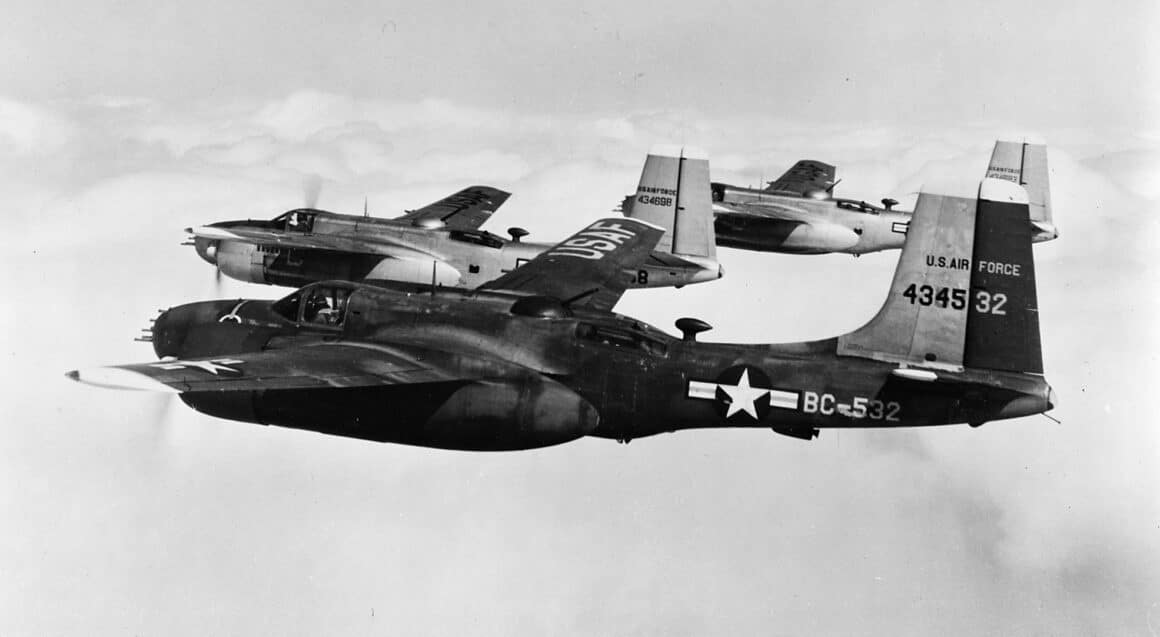Serving Between Wars
When the United States Air Force was born in 1947 they were still operating A-26Bs and A-26Cs around the world. Not long thereafter the A-26 became the B-26. Strategic Air Command (SAC) operated many of them, designated as RB-26s. When war came to the Korean peninsula in June of 1950, B-26C Invaders of the 3rd BG operating from bases in southern Japan, were some of the first US Air Force aircraft engaged in the Korean War, carrying out missions over South Korea on 27 and 28 June. On 29 June they carried out the first USAF bombing mission to North Korea when they bombed an airfield near Pyongyang.

To War Again in Korea
The Air Force Reserve’s 452nd Bombardment Wing was activated for Korean service on 10 August 1950 and flew their first missions from Japan against targets in Korea in November. The Wing’s 8th, 13th, and 90th Bomb Squadrons flew their missions at night. After moving from one base to another several times, the 452nd ended up at Kunsan (K-8) with the 3rd BG for the duration of the war in Korea. A few modified WB-26s and RB-26s of the 67th Tactical Reconnaissance Wing (TRW) flew critical weather observation and reconnaissance missions in supporting roles.

Invaders on a Rampage
On 14 September 1951, Captain John S. Walmsley, Jr. and his crew attacked a supply train. When his guns jammed, he illuminated the target with his searchlight to enable his wingmen to destroy the train. Walmsley was shot down and posthumously awarded the Medal of Honor. B-26C Invaders carried out the last USAF bombing mission of the war 24 minutes before the Armistice Agreement was signed on 27 June 1953. B-26s were credited with the destruction of 38,500 vehicles, 406 locomotives, 3,700 railway cars, and seven enemy aircraft on the ground.

A True Multi-Mission Machine
Other B-26 variants included the dual-control TB-26B and TB-26C trainers, the DB-26B and DB-26C drone controllers, and CB-26B and VB-26B VIP transports. TB-26s were used as proficiency trainers and target tugs. A few of them ended up as ground trainers, designated GB-26B and GB-26C. The DB-26s were converted to carry a Ryan Firebee drone under each wing and the radios to control them were added. CB-26s and VB-26s were stripped of mission equipment and fitted out with interior seating in the fuselage aft of the bomb bay.

Cold War Warriors
B-26Bs and B-26Cs returned to Europe during the early years of the Cold War. The Air National Guard’s 126th BW activated in April of 1951 and began flying out of Bordeaux-Merignac airfield in France in December of 1951. U.S. Air Forces in Europe continued operating the B-26 Invaders until 1957. Tactical Air Command (TAC) and TAC-gained Air National Guard units operated them until 1966 (and a few beyond then). In December of 1960 B-26B, B-26C, and RB-26C Invaders operated by the Central Intelligence Agency (CIA) began turning up in Southeast Asia to assist the Laotian government in their fight against the Pathet Lao. These aircraft eventually wound up flying with the South Vietnamese under Project Farm Gate. But B-26s, and the various derivations thereof, continued to play a role in Southeast Asia.

Building a Better Invader
After two 1st Air Commando Wing pilots perished when the B-26 they were flying lost a wing during a demonstration flight on 11 February 1964, the Air Force selected the On Mark Engineering Company to upgrade the B-26B and B-26C Invaders for a counterinsurgency (COIN) role. On Mark converted a total of 40 B-26B and B-26C Invaders to the new B-26K Counter-Invader configuration. These aircraft had uprated P&W R-2800 engines and propellers, re-manufactured wings, wing tip fuel tanks, additional radio and communications gear, deletion of the gun turrets, and improved brakes. Cameras for reconnaissance or aerial survey work could be installed in the bomb bay. Initial flight of the first B-26K-OM was in 26 May 1964, with the last delivered in 1965. The Counter Invaders were assigned to the 606th Special Operations Squadron of the 1st Air Commando Wing. They and the 609th SOS flew night interdiction mission over the Ho Chi Minh Trail (and Laos) out of Nakhon Phanom (NKP) Airbase in Thailand.

